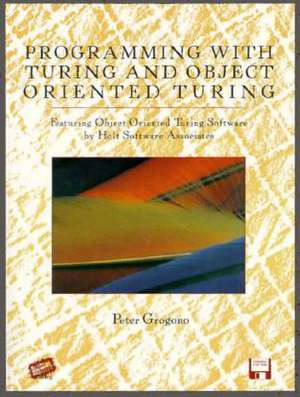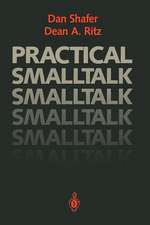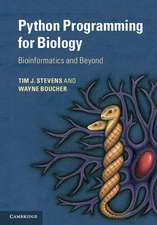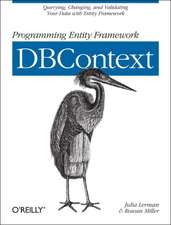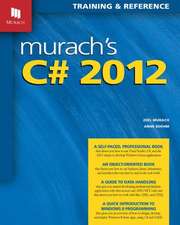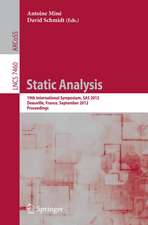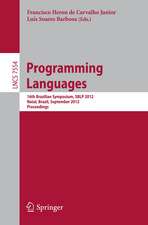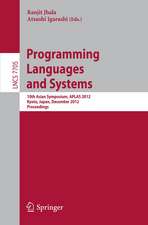Programming with Turing and Object Oriented Turing
Autor Peter Grogonoen Limba Engleză Paperback – 29 iun 1995
Preț: 341.15 lei
Preț vechi: 426.44 lei
-20% Nou
Puncte Express: 512
Preț estimativ în valută:
65.28€ • 68.34$ • 54.01£
65.28€ • 68.34$ • 54.01£
Carte tipărită la comandă
Livrare economică 05-19 aprilie
Preluare comenzi: 021 569.72.76
Specificații
ISBN-13: 9780387945170
ISBN-10: 0387945172
Pagini: 392
Ilustrații: XV, 392 p.
Dimensiuni: 178 x 235 x 25 mm
Greutate: 0.66 kg
Ediția:1995
Editura: Springer
Colecția Springer
Locul publicării:New York, NY, United States
ISBN-10: 0387945172
Pagini: 392
Ilustrații: XV, 392 p.
Dimensiuni: 178 x 235 x 25 mm
Greutate: 0.66 kg
Ediția:1995
Editura: Springer
Colecția Springer
Locul publicării:New York, NY, United States
Public țintă
ResearchCuprins
1 First Concepts.- 1.1 Writing Simple Programs.- 1.2 Learning to Read Programs.- 1.3 Introduction to Standard Types.- 1.4 Declarations.- 1.5 Output and Input.- 1.6 Comments.- 1.7 Summary.- 1.8 Exercises..- 2 Assignment and Control.- 2.1 The Assignment Statement.- 2.2 Sequences.- 2.3 Decisions.- 2.4 Repetition.- 2.5 Scopes and Local Declarations.- 2.6 The Form and Content of Statements.- 2.7 Summary.- 2.8 Exercises.- 3 Standard Types and Expressions.- 3.1 The Role of Types in Programs.- 3.2 The Typesint and real.- 3.3 The Type boolean.- 3.4 The Type string.- 3.5 Type Conversion.- 3.6 Summary.- 3.7 Exercises.- 4 Defining New Types.- 4.1 Subranges.- 4.2 Enumerations.- 4.3 Arrays.- 4.4 Summary.- 4.5 Exercises.- 5 Procedures and Functions.- 5.1 Predefined Procedures and Functions.- 5.2 Declaring New Procedures.- 5.3 New Functions.- 5.4 Recursive Subprograms.- 5.6 Rules for Subprograms.- 5.7 Preconditions and Postconditions.- 5.8 Summary.- 5.9 Exercises.- 6 Input and Output.- 6.1 Managing the Keyboard.- 6.2 Managing the Screen.- 6.3 Text Files.- 6.4 Summary.- 6.5 Exercises.- 7 Sound and Graphics.- 7.1 Sound.- 7.2 Graphics.- 7.3 Animation.- 7.4 Summary.- 7.5 Exercises.- 8 Sets, Records, and Unions.- 8.1 Sets.- 8.2 Records.- 8.3 Unions.- 8.4 The bind Statement.- 8.5 Summary.- 8.6 Exercises.- 9 Collections.- 9.1 Prom Arrays to Collections.- 9.2 Linked Lists.- 9.3 The new and free Statements.- 9.4 Collections and Recursion.- 9.5 Designing a Symbolic Calculator.- 9.6 Summary.- 9.7 Exercises.- 10 Organizing Large Programs.- 10.1 Modules.- 10.2 The include Directive.- 10.3 Summary.- 10.4 Exercises.- 11 Additional Features.- 11.1 Binary Files.- 11.2 Subprogram Arguments.- 11.3 Summary.- 11.4 Exercises.- 12 Object Oriented Turing.- 12.1 Classes and Objects.- 12.2 Inheritance.- 12.3 Frameworks.- 12.4 Ancestors and Descendants.- 12.5 Summary.- 12.6 Exercises.- Appendixes.- A Turing Keywords.- B Expression Operators.- C Assignment Operators.- D Predefined Functions and Procedures.- E Codes for the ASCII Graphic Character Set.- F ASCII Codes for Border Characters.- J Colors for the IBM PC and Compatibles.- K Installing WinOOT.- L Running WinOOT.- Index 379.
